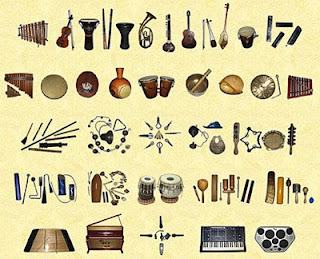North Africa has
contributed much to popular music: Egyptian classical & el Gil; Algerian raï
& Moroccan chaabi. The region of North Africa (with the exception of Egypt) is referred to as the Maghreb.
For mostly political & religious reasons popular musick has seen its fair share of
oppression. Yet music still thrives there despite frequent condemnation &
suppression from the respective governments. Modern music blends with time
honored traditional styles from groups like the Berbers, the Sephardic Jews, Tuaregs,
& Nubians, retaining musical traditions with ancient roots.
Hundreds of miles of sparkling white beaches along the blue
Mediterranean laps only a few steps away & the rattle of palm fronds in the
wind is the only sound. Then we enter the beautiful Gulf
of Tunis at the port of Halq al Wadi. On to Tunis, the capital of Tunisia. The central part of Tunis is the century old
medina, a dense agglomeration of alleys & covered passages, full of intense
scents & colors. Beyond this district lie the suburbs of Carthage, La Marsa, & Sidi Bou Said.
Exotic Tunisia.
Just the thoughts of Tunisia
brings forth music to the mind.
The colonialist French had deep roots in the North Africa
region, particularly in Morocco,
Algeria, Libya, & Tunisia. The French love of jazz
firmly gripped many in Tunisia.
Every jazz enthusiast is familiar with “Night in Tunisia” by Dizzy Gillespie. Well,
here is some jazz you might actually hear some night in Tunisia.
For more than forty years Fawzi Chekili has worked for the
promotion of jazz in Tunisia.
He plays mainly the guitar, but also the piano & the ùd.
The ùd or oud is a pear-shaped stringed instrument commonly
used in many Mediterranean countries. It is prevalent throughout North Africa. The ùd lacks frets & has a smaller
neck than the South European lute. It is considered an ancestor of the guitar.
According to Abū Naṣr Muḥammad ibn Muḥammad Fārābī, a late 9th
to mid 10th Century scientist, philosopher, cosmologist, logician,
& musician, the ùd was invented by Lamech, the sixth grandson of Adam. Legend
tells that the grieving Lamech hung the body of his dead son from a tree. The
first ùd was inspired by the shape of his son's bleached skeleton. The oldest
pictorial record of a ùd appears on a cylindrical seal dating back to the Uruk
period in southern Mesopotamia over 5000 years
ago.
While studying English Letters in the U.K., Fawzi
Chekili became impassioned with music & jazz in particular. Currently a
professional musician & teacher in Tunis,
he is active both locally & internationally. With over ten albums to his
credit, Fawzi Chekili blends the colors of his native Tunisia with the
sophisticated harmony of jazz.
Fawzi Chekili – Taqasim, Blue Jasmin, 1993.
decryption code in comments
Tracklist –
Hijez
Malouf Funk
Ashtar
Selma's
Mosaic
Metis
Hafla Jazz
Mawel
Taqasim
%%%%%%%%%%%%%%%%%%%%%%%%%%%%%%%%%%%%%
Ghalia Benali was born in Brussels in 1968. At age three she moved with her family to the south of Tunisia. Here she grew up in an artistic family. Early on she was introduced to music & poetry : French chanson, Egyptian & Indian musicals; melodies from Syria; the Egyptian singer Umm Kulthum; & the sung readings from the Koran. Even as a toddler she sang & performed Arabian & Indian dances at family parties.
Ghalia is one of the musical surprises to emerge from the
Arab world at the turn of the millennium. A successful actress, she played a
leading role in the film “La saison des homes”. Her highly acclaimed concerts in Tunis, Paris, & Brussels had the record
companies queuing up to sign her, but she preferred to wait until she had found
her dream line-up.
Thus the formation of Timnaa, an international ensemble
whose virtuoso fiddles, flamenco guitars & Arab percussion carry her
expressively smoky, profoundly emotional voice from Tunisia to the world.
Ghalia herself describes Timnaa as “Arab music in new form, sometimes festive
but never profane, occasionally romantic & elegiac, or even classical &
medieval, sometimes wild & over the top – a passport to many cultures, a
microcosm that merges the centuries into something new”.
Tracklist –
Lennass Aideen
Rubaiyat
River
Ya M’safer
Quala’nnnass
Romeo & Leila
Acceptance
Kitabi Ya Sidi Ya Baba
NØ









Fawzi Chekili
ReplyDeletecGkgJiBkrd_CP-8by-rlujhxkY4kEU4Qkj-OJ-B0tMw
Ghalia Benali
ckPMiS41JMTfQ0EuODll4UDp6YMLUukGtJPDEFI8Oto
both of these look like treats.
ReplyDeleterobert